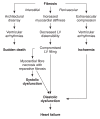Cardiomyopathies and myocardial disorders in Africa: present status and the way forward
- PMID: 23192260
- PMCID: PMC3721909
- DOI: 10.5830/CVJA-2012-046
Cardiomyopathies and myocardial disorders in Africa: present status and the way forward
Abstract
A review of heart diseases in Africa shows that the cardiomyopathies continue to be important causes of morbidity and mortality in the population. Hypertension remains the commonest cause of myocardial disease, followed by the cardiomyopathies. Ischaemic heart disease continues to be rare. Of the cardiomyopathies, dilated cardiomyopathy (DCM) is still the commonest. A large proportion of patients diagnosed with DCM in Africa have been shown to be cases of hypertensive heart failure, with varying degrees of myocardial dysfunction. Hypertrophic cardiomyopathy, which in the past was thought to be rare among Africans, has been shown to have the same prevalence as in other parts of the world. Moreover it is now known to be a genetic disorder. Endomyocardial fibrosis has become rare in communities where it used to be common. Its aetiology continues to be elusive. Arrhythmogenic right ventricular cardiomyopathy has been reported among Africans but there are no reports of left ventricular non-compaction or the ion channelopathies from Africa. Lenegre disease and the long-QT syndromes are well-known entities in clinical practice in Africa although long-QT in Africa is associated with potassium deficiency arising from prolonged treatment with diuretics. Left ventricular non-ischaemic aneurysms still occur but are rare. In view of these, a new classification of myocardial disorders was proposed for Africa.
Figures





Comment in
-
Cardiomyopathies and myocardial disorders in Africa: present status and the way forward.Cardiovasc J Afr. 2013 Apr;24(3):65, 71. Cardiovasc J Afr. 2013. PMID: 23736128 Free PMC article. No abstract available.
-
Isolated left ventricular non-compaction in Africa: elucidating myths.Cardiovasc J Afr. 2013 Jun;24(5):188. Cardiovasc J Afr. 2013. PMID: 24217167 Free PMC article. No abstract available.
-
Cardiomyopathies and myocardial disorders in Africa: present status and the way forward.Cardiovasc J Afr. 2013 Sep;24(8):329. Cardiovasc J Afr. 2013. PMID: 24240379 Free PMC article. No abstract available.
References
-
- Carlisle R, Ogunlesi TO. Prospective study of adult cases presenting at the Cardiac Unit, University College Hospital, Ibadan 1968 and 1969. Afr J Med Sci. 1972;3:13–25. - PubMed
-
- Ogah OS, Adegbite GD, Akinyemi OO. et al. Epidemiology of Acute Heart Failure in Southern Nigeria: Data From The Abeokuta Heart Failure Registry (Abstract). Circulation. 2010;122:e116.
-
- Reesinger JA, Blumenthal B. Myocardial degeneration with hypertrophy and failure of unknown case. Am Heart J. 1941;22:811–824.
Publication types
MeSH terms
LinkOut - more resources
Full Text Sources
Medical
Miscellaneous

